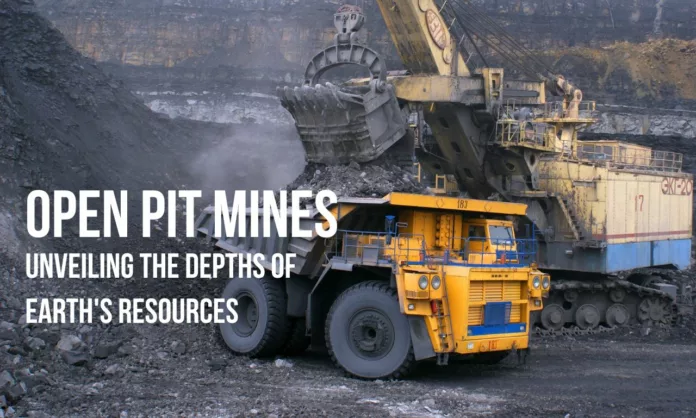Open pit mines are vast excavations that expose mineral deposits and other valuable resources lying beneath the Earth’s surface. These mining operations are characterized by their impressive scale and visible impact on the surrounding landscapes. Open pit mining has played a significant role in the extraction of minerals and fuels, shaping industries and economies worldwide. In this article, we will delve into the world of open pit mines, exploring their features, benefits, environmental concerns, and technological advancements.
Table of Contents
Understanding Open Pit Mines
Open pit mines, also known as open-cast or open-cut mines, are large-scale mining operations conducted on the Earth’s surface. Unlike underground mines, open pit mines involve the removal of overburden (the top layer of soil and rock) to expose the desired mineral deposits. This method is commonly used to extract minerals such as copper, gold, iron, coal, and diamonds.
Features and Operations
Open pit mines exhibit several distinctive features and operational processes. These include:
- Planning and Design: Open pit mines require extensive planning and design to ensure efficient extraction and safety. Engineers analyze geological data, assess deposit characteristics, and develop strategies for optimal excavation and resource recovery.
- Overburden Removal: Before extracting the desired minerals, the overlying layers of soil and rock must be removed. This process involves the use of heavy machinery, such as bulldozers, excavators, and haul trucks, to strip away the top layers and create access to the mineral deposits.
- Drilling and Blasting: Once the overburden is removed, drilling and blasting techniques are employed to fragment the rocks and facilitate extraction. Explosives are carefully placed and detonated to break the rocks into manageable pieces.
- Extraction and Haulage: Mining equipment, such as shovels and loaders, is used to excavate and transport the minerals to processing facilities. Large haul trucks, capable of carrying hundreds of tons, move the extracted material from the pit to designated areas for further processing.
- Rehabilitation and Closure: After the resource extraction is complete, open pit mines undergo rehabilitation and closure processes. These involve recontouring the landscape, stabilizing slopes, and restoring vegetation to mitigate the environmental impact caused by the mining operations.
Benefits of Open Pit Mining
Open pit mining offers several advantages over other mining methods, including:
- Higher Resource Recovery: Open pit mines allow for a higher recovery of resources compared to underground mining methods. The large-scale excavation and accessibility of mineral deposits enable efficient extraction and utilization of valuable resources.
- Economic Significance: Open pit mining has been a significant contributor to the economic growth of many regions. It creates job opportunities, stimulates local economies through infrastructure development, and generates revenue through royalties and taxes.
- Safety: Open pit mining is generally considered safer than underground mining, as it offers better visibility, easier access for personnel and equipment, and reduced risks associated with underground collapses.
Environmental Concerns
While open pit mining brings economic benefits, it also raises environmental concerns. These include:
- Land Disruption: Open pit mines alter the landscape significantly, causing land degradation and habitat destruction. The removal of overburden and extraction of minerals can result in the loss of biodiversity and disruption of ecosystems.
- Water Management: Open pit mines can impact water resources. The removal of overburden and exposure of rocks can lead to acid mine drainage, a process where sulfuric acid is formed, polluting nearby water bodies and affecting aquatic life.
- Air and Noise Pollution: Mining activities, such as blasting, drilling, and heavy machinery operations, can generate dust, particulate matter, and noise pollution. Proper management and control measures are necessary to minimize these impacts on nearby communities.
Technological Advancements
Advancements in technology have revolutionized open pit mining, making it more efficient and environmentally friendly. Some notable advancements include:
- Remote Sensing and Imaging: Satellite imagery and aerial drones are utilized for surveying, monitoring, and planning open pit mines. These technologies provide accurate data on topography, terrain stability, and environmental conditions.
- Autonomous Vehicles: Self-driving haul trucks and robotic equipment are being introduced to open pit mining operations. These technologies enhance efficiency, reduce human error, and improve worker safety.
- Advanced Extraction Techniques: Innovations such as in-pit crushing and conveying systems, and bioleaching, have improved the efficiency and environmental performance of open pit mines. These techniques reduce the need for excessive hauling and use environmentally friendly processes for mineral extraction.
Conclusion:
Open pit mines have played a crucial role in resource extraction, powering industries and economies globally. While they offer significant economic benefits, it is vital to address and mitigate the environmental impact associated with these mining operations. Technological advancements continue to enhance the efficiency and sustainability of open pit mining, enabling the industry to adapt to evolving environmental and societal expectations. With responsible planning, improved practices, and ongoing innovation, open pit mining can continue to be a valuable source of the Earth’s resources while minimizing its ecological footprint.

